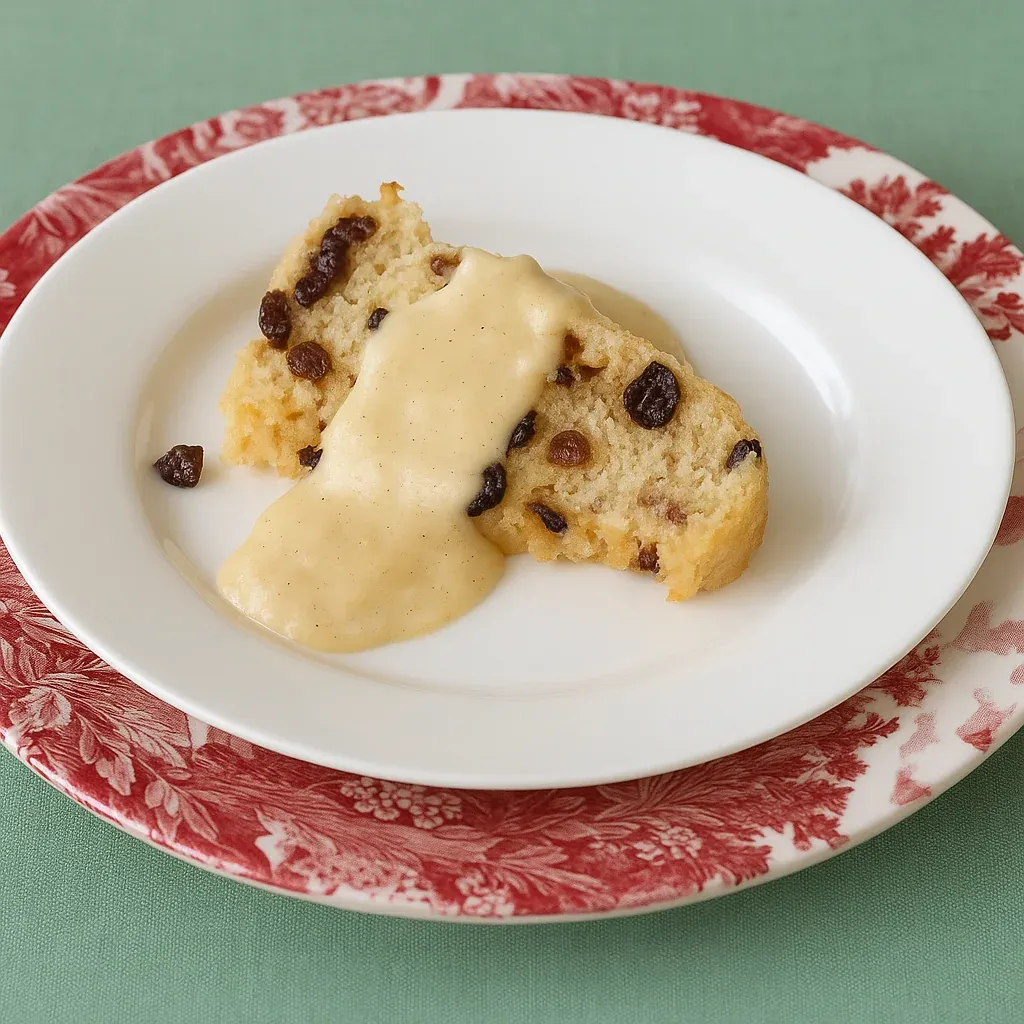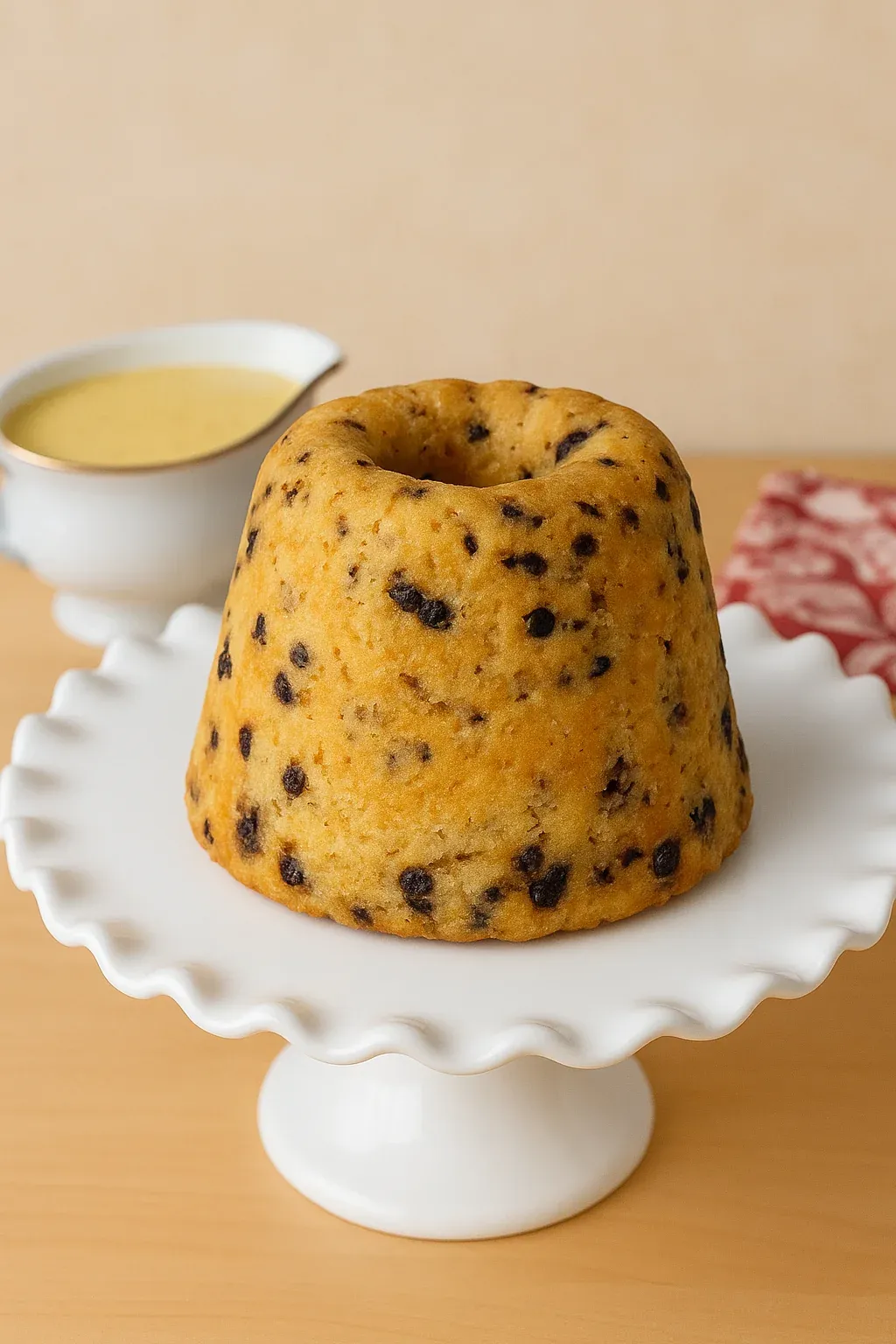 Pin it
Pin it
Our family has treasured this Classic Spotted Dick for generations. It's an amazing mix of basic ingredients that come together in a warm, British pud that always makes everyone at my table grin from ear to ear.
I first whipped this up one freezing winter night after finding my grandma's handwritten recipe card. The smell that filled my kitchen took me straight back to Sunday lunches in England when I was little. It's now become my go-to dessert whenever we celebrate holidays.
Ingredients
- All Purpose Flour: This makes up the base of our pudding and helps create that soft, tender bite. Try to grab unbleached if you can for better flavor
- Baking Powder: This gives us that fluffy, light texture we want. Double-check yours isn't expired for the best rise
- Salt: This cuts through the sweetness and makes all the other flavors pop. Regular kosher salt does the job nicely
- Beef Suet: This brings the old-school richness that makes a proper Spotted Dick. You can find it at British food shops or swap in ice-cold grated butter if needed
- Caster Sugar: This adds sweetness without being heavy. Don't worry if you only have regular sugar – that works too
- Dried Currants: These make those classic spots and add little bursts of sweetness throughout. Pick plump ones without any added oils
- Milk: This pulls everything together and adds moisture. Whole milk works best for richness
- Vanilla Extract: This rounds everything out with cozy flavor notes. Go for the real stuff instead of imitation if you can
- Lemon Zest: This lifts the whole dessert with a bit of citrus zing. Try to use organic lemons for zesting if possible
- English Custard Sauce: This finishes it off with creamy goodness. Homemade is amazing but store-bought is totally fine too
Step-by-Step Instructions
- Set Up Your Steamer:
- Put some metal cookie cutters or a folded kitchen towel in the bottom of a big pot. This important step makes sure there's space under your pudding mold so it doesn't burn and lets steam move around properly. Add about 3 inches of water and bring it to a soft boil. While that's happening, grease a 1.6-liter pudding mold really well, getting into all the corners so your pudding comes out clean later.
- Combine Dry Stuff:
- Put flour, sugar, baking powder, salt and suet in a food processor. Give it a few pulses until it looks like damp sand with tiny bits of fat scattered throughout. This texture is key for getting that light, tender crumb that makes steamed puddings so good. Dump this mix into a big mixing bowl, making sure to get everything out of the processor.
- Mix In Wet Ingredients and Currants:
- Add your milk, lemon zest, vanilla, and currants. Stir everything together with a wooden spoon using gentle but thorough movements until you've got a thick, even batter with no dry patches. The batter should be firm enough to hold its shape but soft enough to spoon into the mold easily.
- Add Batter to Mold:
- Spoon your batter into the greased mold, pressing down gently to get rid of air bubbles while making the top flat. Leave about half an inch of space at the top since it'll expand while steaming. Put the lid on tight to make sure no water can get in during cooking.
- Cook the Pudding:
- Carefully lower your sealed mold into the gently boiling water, making sure the water comes halfway up the sides of the mold. Turn the heat down so it's just simmering rather than boiling hard. For the real deal with suet, steam for 3-4 hours, checking the water level every 30 minutes and adding more boiling water if needed. If you're using butter instead of suet, about 90 minutes usually does the trick.
- Cool Briefly:
- Take the mold out of the pot using oven mitts or tongs and set it on a cooling rack. Let it sit untouched for exactly 15 minutes, which helps the pudding settle before you turn it out. This resting time really improves the final texture and stops it from falling apart.
- Serve:
- Flip the pudding onto a warm serving plate, using a butter knife around the edges if it needs a bit of help. If you prepped it right, it should drop out cleanly with a satisfying thud. Cut into big wedges and serve right away with warm custard sauce poured generously over each piece, letting it soak a bit into the warm pudding.
 Pin it
Pin it
My grandma always said the suet quality makes or breaks this dessert. She'd go to her butcher just to ask for fresh beef suet that she'd grate herself instead of using the packaged stuff. I can still picture her hands working fast while she told me stories about making this pudding when food was rationed during the war, using whatever dried fruit they could find and treasuring those rare times when they could get all the proper ingredients.
Historical Context
Spotted Dick showed up in British kitchens during Victorian times, around the middle of the 19th century, when steamed puddings got popular because they used ingredients efficiently and didn't need an oven. The name probably comes from "dick" being a local word for pudding, while "spotted" refers to the dried fruit dotted throughout. It started out as everyday food for working folks but soon everybody loved it, no matter how rich or poor. The traditional use of suet made sense in times before refrigerators. These days, this dessert stands for food heritage and brings back fond memories of Britain's cooking traditions.
 Pin it
Pin it
Storage and Reheating
Spotted Dick stays good for quite a while after you make it. Wrap any leftovers tightly and keep them in the fridge for up to 5 days. The flavors actually get better during the first day or two. To reheat, you can zap individual slices in the microwave for 30-45 seconds, or put the whole pudding back in its mold and steam it for 30 minutes until it's hot all the way through. Another option is to wrap portions in foil and warm them in a 300°F oven for about 15 minutes. Always add fresh warm custard when serving rather than reheating pudding that already has custard on it. This pudding also freezes really well for up to three months. Just let it thaw in the fridge overnight before warming it up for the best texture.
Ingredient Substitutions
Though the traditional stuff gives you the most authentic result, you can still make a great pudding with some swaps. If you can't find beef suet, just grate very cold butter using the big holes on your grater. For folks with dietary needs, vegetable suet works fine too. No currants? Try raisins, golden raisins, or even dried cranberries for a new twist. Need dairy-free? Almond or oat milk works well. If you're going gluten-free, baking blends made for that purpose can replace the wheat flour, though your pudding might be a bit denser. Want it extra rich? Use half milk and half heavy cream. Whatever swaps you make, just keep the same ratio of wet to dry ingredients so your batter has the right thickness.
Frequently Asked Questions
- → What's inside Spotted Dick?
This dessert combines suet (or butter), flour, sugar, baking powder, salt, currants, milk, lemon zest, and vanilla. Its name comes from the currants, which create the 'spots' in the pudding.
- → What pairs well with Spotted Dick?
Warm English custard is the perfect match for Spotted Dick. Its creamy texture and mild sweetness enhance the pudding's soft texture and fruity flavor.
- → Can butter replace suet for Spotted Dick?
Sure! Butter works well as an alternative. But suet gives it an authentic texture and flavor for a traditional spin.
- → How long should Spotted Dick steam?
You’ll need 3-4 hours to steam with suet. If you opt for butter, 90 minutes is enough for a tasty result.
- → Can I personalize my Spotted Dick?
Definitely! Switch currants with raisins or sultanas, or sprinkle in spices like nutmeg or cinnamon for a warmer twist.
- → How do I keep leftovers fresh?
Place leftovers in an airtight box and refrigerate for up to three days. Rewarm them in the microwave or steamer before eating.
